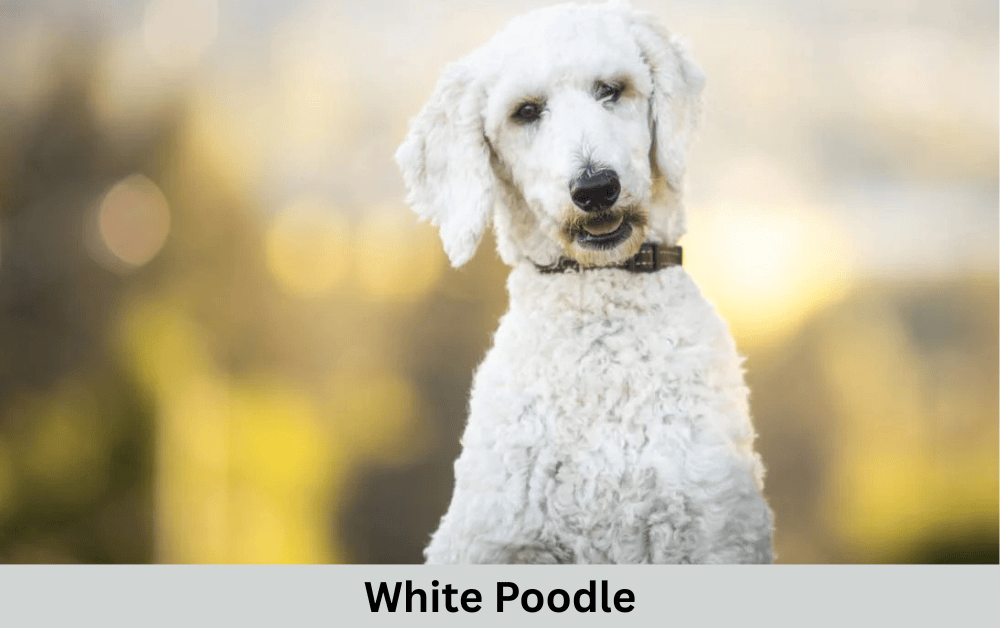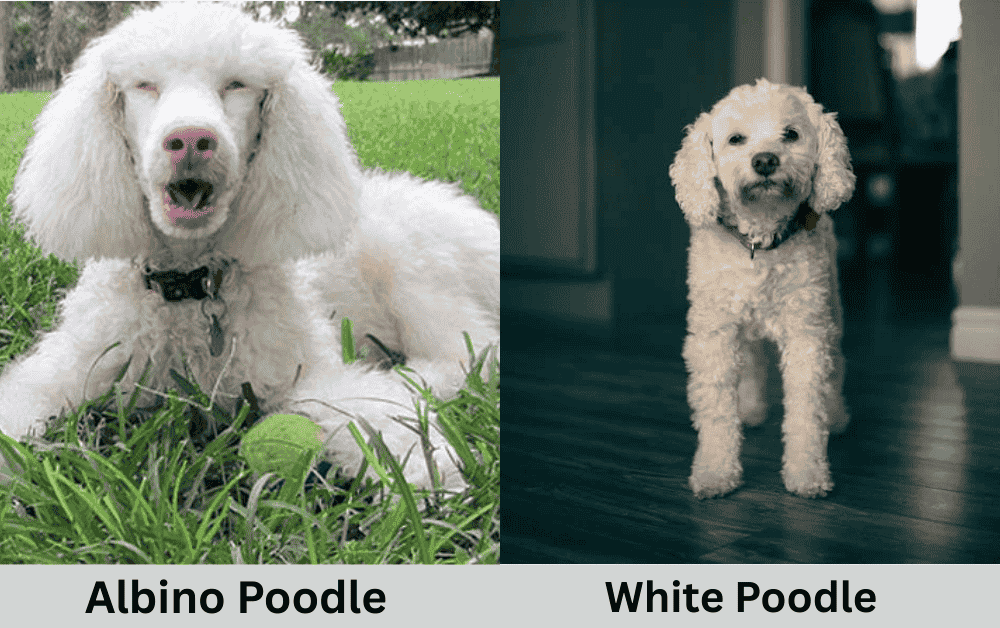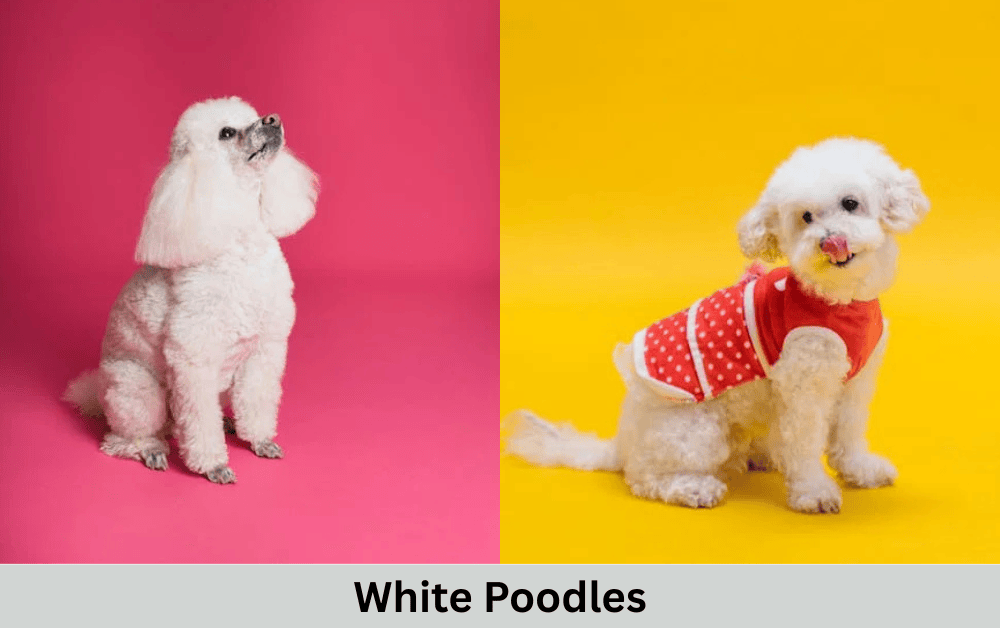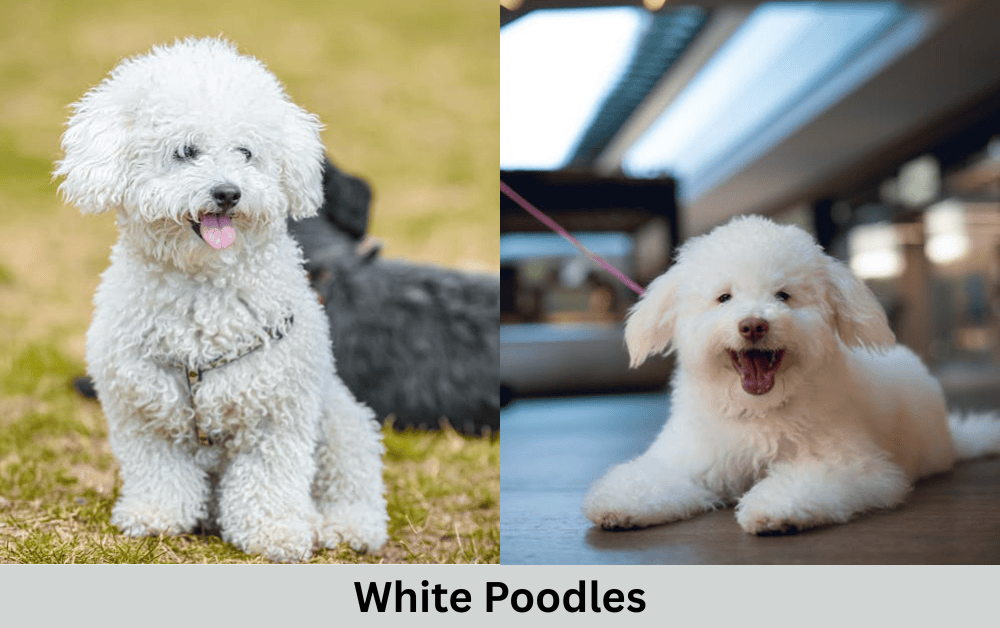Introduction
Many owners pick white Poodles for their classy look and easy-to-maintain coats with proper grooming. They pick up commands quickly, love spending time with people, and adapt to any home, whether a small apartment or a big house with a yard. These dogs also shine in activities like agility training, learning tricks, and even comforting people as therapy pets. Their mix of looks and intelligence makes them a top choice for families, seniors, and new dog owners.
History & Origin of White Poodles
Many people believe Poodles are French, but their story began in Germany more than 400 years ago. Hunters trained Standard Poodles to retrieve ducks from lakes and rivers. The name “Poodle” comes from the German word “pudel,” meaning “to splash in water.” The breed’s popularity grew when French nobles fell in love with them in the 1700s. French breeders refined the Poodle’s appearance, creating the elegant look we know today. This connection made the Poodle France’s national dog, even though it’s originally German, as documented by the American Kennel Club.
The Standard Poodle worked first as a hunting dog and entertainer. Breeders developed the smaller Miniature Poodle in the 1800s for city living. Americans later created the tiny Toy Poodle in the early 1900s as a perfect lap dog. White Poodles became stars in late 1800s dog shows. Their snow-white coats stood out in competitions. By the 1950s, white had become one of the most sought-after Poodle colors for both shows and family homes.
White Poodle Appearance

Three Sizes of White Poodles
- White Toy Poodles – Petite and portable (under 10 inches tall, 6–9 pounds).
- White Miniature Poodles – Small but sturdy (10–15 inches tall, 10–15 pounds).
- White Standard Poodles – Tall and elegant (over 15 inches tall, 40–70 pounds).
White Poodles have white coats, but that doesn’t mean they are albino. You can tell the difference by looking at their features. A true white Poodle has black “points.” This means they have black noses, eye rims, lips, and paw pads. Their eyes are dark brown or black. These black features show that they have normal pigment.
Albino Poodles have pink or very light skin, blue or light-colored eyes, and lack pigment in their features. Albino dogs are also more sensitive to sunlight and may have health problems.
White Poodle Temperament and Personality
Perfect Companions For:
- Families with children (best with kids 6+ years)
- First-time dog owners
- Seniors wanting an active but manageable pet
- Homes with other pets (when properly introduced)
Daily Needs:
- 45-60 minutes of activity (walks, play sessions)
- Mental challenges (puzzle toys, trick training)
- Social interaction (they dislike being left alone)
These adaptable dogs switch easily between energetic play and calm snuggles. They excel at games like fetch and hide-and-seek, but also enjoy learning new tricks. Early socialization helps them stay confident around strangers, other dogs, and even cats.
White Poodles communicate clearly with alert barks and expressive eyes. While generally quiet, they’ll let you know when visitors arrive. Their sensitive nature means they respond best to positive training with lots of praise.
Owner Experience: Luna, my white Poodle, brightens every day. She learned “sit” and “shake” in one week! We enjoy walks, playtime, and cuddles. Her fluffy coat needs weekly brushing, but her happy prance after grooming makes it worthwhile. Luna greets everyone with wagging tails, never barks too much, and loves learning tricks. Smart, loyal, and full of love – she’s the perfect companion. White Poodles like Luna make life happier.
Are White Poodles Rare?
White vs. Cream vs. Apricot Poodles
- White Poodle: Pure snow-white fur with black noses/pads (no yellow tint)
- Cream Poodle: Warm, pale yellow-white (lighter than apricot)
- Apricot Poodle: Peachy-orange tones (more vibrant than cream)
Breeding & Popularity
Good breeders focus on health and temperament first, not just color. White Poodles often do well in dog shows, so demand for their puppies stays high. Always pick a breeder who prioritizes healthy dogs over coat color.
White Poodles vs. Albino Poodles

How Can You Tell the Difference Between True White and Albino Poodles?
It’s easy to spot the difference between a true white Poodle and an albino one:
- Eye color: True white Poodles have dark brown or black eyes, while albino Poodles have light blue or pale pinkish eyes.
- Nose color: A true white Poodle has a black nose, but an albino Poodle has a pink nose.
- Skin tone: Albino Poodles will have very light or pink skin, while true white Poodles have normal pigmentation in their skin that looks pale but not pink.
These features are the best indicators to distinguish between the two.
Health Implications of Albinism in Poodles
Albinism in Poodles comes with certain health challenges. Since albino Poodles lack pigmentation, they can be more sensitive to sunlight. They are more likely to suffer from sunburns, skin damage, and even skin cancer if exposed to the sun for too long. Albino Poodles may also experience vision problems, including sensitivity to light and other eye conditions like strabismus (crossed eyes).
Owners of albino Poodles should be extra careful about protecting their poodle dogs from the sun and ensuring they have regular veterinary check-ups to monitor their health.
White Poodle Grooming: How to Keep the White Coat Bright?

Brush your white Poodle at least 3-4 times a week. This regular brushing helps keep their coat shiny and free of tangles. It also prevents matting and spreads natural oils, making their fur soft. White Poodles need frequent brushing to avoid dirt buildup, which can be very visible on their light-colored fur.
What Shampoo and Coat Whitening Products Should You Use?
Use a shampoo designed for white dogs to keep your Poodle’s coat bright and white. These poodle shampoos help remove stains and keep your Poodle’s coat sparkling. Look for whitening shampoos with optical brighteners that improve the coat’s whiteness. Avoid harsh products, as they can dry out your dog’s skin. You can also use whitening sprays or conditioners to give the coat a shiny finish and prevent dullness.
Tear Staining: Causes, Prevention, and Treatment
Tear stains are common in white Poodles. These stains happen when tears mix with fur and cause reddish-brown discoloration. They can be caused by excessive tearing, allergies, or blocked tear ducts.
Wipe your Poodle’s face daily with a soft, damp cloth to prevent tear stains. You can also use tear stain removers or natural options like baby wipes to clean around the eyes. If your Poodle experiences frequent tear stains, consult your vet, as it might be a sign of an eye infection or blocked tear ducts.
Cleaning Your Poodle’s Ears, Eyes, and Paws
Regular cleaning is key to keeping your white Poodle healthy and comfortable.
- Ears: Check your Poodle’s ears once a week for dirt, wax, or infection. Use a vet-approved ear cleaner to gently clean them and avoid infections.
- Eyes: Wipe away any discharge or debris from your Poodle’s eyes. Use a soft cloth to keep their eyes clean.
- Paws: Clean your Poodle’s paws after walks to remove dirt or debris. You can use a paw cleaner or a damp cloth to wipe their paws.
Grooming Styles for White Poodles
White Poodles look stunning with various poodle clips. Here are a few popular options:
- Teddy Bear Cut: This style gives your Poodle a soft, round face and body, making them look extra cuddly and adorable.
- Continental Cut: Often seen in dog shows, the Continental Cut involves shaving the body short while leaving the fur on the legs and tail puffy. This cut shows off the Poodle’s elegance and grace.
No matter which style you choose, regular poodle grooming sessions are important to keep your white Poodle’s coat bright and healthy.
Exercise & Mental Stimulation Needs
White Poodles are active dogs that need at least 30-60 minutes of exercise every day. A daily walk is essential to keep them fit and healthy. You can also include playtime in your yard or take them to a dog park for extra fun. Keeping them active helps prevent boredom and keeps their energy levels in check.
How Can You Keep a White Poodle Mentally Stimulated?
White Poodles are very smart and enjoy mental challenges. To keep their minds sharp, try these activities:
- Interactive Toys: Toys that make your Poodle think, like treat-dispensing toys or puzzle feeders, can keep them busy and entertained.
- Games: Play games like hide-and-seek or fetch to engage their brain and body.
- Training: Teach your Poodle new tricks or reinforce basic commands like “sit,” “stay,” or “come.” Mental stimulation from training helps them stay focused and prevents boredom.
What Activities Are Suitable for White Poodles?
White Poodles enjoy many activities that help them stay both physically and mentally stimulated:
- Agility Training: Poodles excel in agility courses. Running through tunnels, jumping over hurdles, and weaving between poles will keep them active and help strengthen their bond with you.
- Swimming: Poodles are natural swimmers. If you have access to a pool or a safe swimming area, swimming is a great way to exercise while having fun.
- Obedience Training: Poodles love learning, and obedience classes are an excellent way to provide them with mental stimulation while improving their behavior.
Incorporating a mix of physical and mental exercises will ensure your white Poodle stays happy, healthy, and well-behaved.
Training White Poodles

White Poodles are very intelligent, and they learn quickly. However, they can be stubborn at times. To train them successfully, use positive reinforcement. Reward your Poodle with treats, praise, or their favorite toy immediately after they follow a command. Consistency is crucial. Always reward good behavior right away to help them understand what they did right.
House Training and Crate Training Tips
Training your White Poodle to be house-trained requires patience. Follow these steps to help:
- House Training: Take your Poodle outside regularly, especially after meals, naps, and playtime. When your Poodle goes outside, praise and reward them. Establish a consistent routine, and they’ll learn faster.
- Crate Training: Crate training provides your Poodle with a safe, secure space. Make the crate inviting by adding a comfy bed and some toys. Start by leaving them in the crate for short periods, and gradually increase the time. Never use the crate as punishment.
Socialization Tips for White Poodles
Socializing your White Poodle early on will help them grow into a confident, friendly dog. Introduce them to different people, dogs, and environments. The more experience they have, the better they’ll adapt.
- Introduce them to new dogs in controlled settings, like a dog park or at a friend’s home.
- Expose them to various sounds (vacuum cleaners, cars, etc.) to help prevent anxiety.
- Encourage positive interactions with people, including children and strangers.
Common Behavioral Issues and Solutions
Like all dogs, White Poodles can develop behavioral problems. Here’s how to address common issues:
- Separation Anxiety: White Poodles can get very attached to their owners and may experience anxiety when left alone. To help, gradually increase the time they spend alone. Provide toys or treats to distract them while you’re away.
- Excessive Barking: Poodles love to bark. If your Poodle barks too much, try redirecting their attention. Teach them to be quiet on command to reduce this behavior.
- Jumping on People: Poodles enjoy greeting people, but jumping can be annoying. When your Poodle jumps, avoid giving them attention. Reward them when they sit calmly instead.
With patience, consistency, and positive reinforcement, you can train your White Poodle to be well-behaved and obedient.
White Poodle Training Checklist
| Training Area | Steps | Frequency |
| House Training | Take outside every 2-3 hours. | Regular potty schedule after meals, naps, and playtime. |
| Praise and reward them after they go outside. | ||
| Crate Training | Start with short crate sessions (10-15 minutes). | Gradually increase crate time. |
| Make the crate a positive space with bedding and toys. | Never use the crate as punishment. | |
| Basic Commands | Sit: Hold treat above head and say “sit”. Reward them when they sit. | Daily practice, 5-10 minutes per command. |
| Stay: Ask to sit, say “stay”, gradually increase time. | ||
| Come: Call name, say “come”, reward when they approach. | ||
| Positive Reinforcement | Use treats, praise, or toys as rewards. | Consistently reward good behavior immediately. |
| Socialization | Introduce new dogs in a controlled setting. | 1-2 times a week. |
| Exposed to various people (kids, strangers). | ||
| Familiarize with sounds (vacuum, cars) and settings (parks, crowded areas). | ||
| Separation Anxiety | Gradually leave for short periods. | Daily practice to increase alone time. |
| Use puzzle toys to distract. | ||
| Reward calm behavior when returning. | ||
| Excessive Barking | Redirect attention during barking. | Daily monitoring and redirection. |
| Teach the “quiet” command and reward silence. | ||
| Jumping on People | Ignore your Poodle when they jumps. | Daily practice during interactions. |
| Reward calm behavior (sitting or staying). | ||
| Training Schedule | Morning: 10-minute training session (Basic Commands) | Daily |
| Afternoon: 10-minute socialization (introduce to new dog/person) | ||
| Evening: 15-minute play and exercise session (agility/fetch) |
Health Issues to Watch in White Poodles
White Poodles are generally healthy dogs, but like all breeds, they can be prone to certain health issues. Being aware of these conditions and knowing how to prevent them is important for their well-being. Let’s take a look at common breed-specific issues, some that are more prevalent in White Poodles, and ways to support their health.
Common Breed-Specific Health Issues
- Hip Dysplasia:
- Hip dysplasia occurs when the hip joint doesn’t develop properly. It can cause pain, limping, or difficulty moving. This condition is common in larger Poodles, including the Standard Poodle. Regular exercise and maintaining a healthy weight can help reduce the risk.
- Allergies:
- Poodles can suffer from allergies caused by food, pollen, dust, or even certain chemicals in grooming products. Symptoms include itching, ear infections, and watery eyes. Identifying the allergen and eliminating it from their environment can help manage these issues.
- Progressive Retinal Atrophy (PRA):
- PRA is a genetic condition that leads to gradual vision loss. While it doesn’t cause pain, it can result in blindness over time. Regular vet check-ups and early detection can help manage the condition.
White Poodle-Specific Health Issues
- Tear Stains:
- White Poodles are more likely to develop tear stains due to their lighter coat color. Excessive tearing can stain their fur around the eyes, causing a reddish-brown discoloration. This happens when the tear ducts produce too many tears. Cleaning the area around their eyes with a damp cloth or using a safe tear stain remover can help. Make sure to keep their eyes and face dry to prevent stains from forming.
- Sensitive Skin:
- White Poodles can have more sensitive skin compared to other Poodle colors. Their skin may be more prone to dryness or irritation, especially in harsh weather conditions. Bathing with a gentle, hypoallergenic shampoo and moisturizing their skin after bathing can help keep their coat and skin healthy.
Diet and Supplements to Support Coat and Health
- Diet:
- A healthy, balanced diet is essential for maintaining a shiny coat and supporting overall health. Choose high-quality food with the right balance of protein, fat, and fiber. Look for foods that contain omega-3 fatty acids, which help keep the skin and coat in top condition.
- Supplements:
- Adding supplements to your White Poodle’s diet can support their health. Fish oil and omega-3 fatty acids can help improve coat quality and reduce skin inflammation. For joint health, glucosamine and chondroitin are great for preventing hip dysplasia.
- Hydration:
- Make sure your Poodle has constant access to fresh water. Staying hydrated is crucial for their overall health and helps support their skin and coat.
Living with a White Poodle
White Poodles make life fun, smart, and full of energy. They fit into many homes, whether you live in an apartment or a big house. They love being around people and can handle different routines. In this section, you’ll learn how White Poodles handle space, travel, sounds, and family life.
Apartment vs. House Living
In Apartments:
White Poodles can live happily in apartments. You just need to give them enough exercise and playtime. Take them for daily walks and let them run or play indoors. Without activity, they may bark or chew things out of boredom.
In Houses:
If you live in a house with a yard, your Poodle will enjoy the extra space. Let them run and explore, but stay alert and keep the yard safe. Even with more space, they still need daily walks and fun play sessions.
White Poodles with Kids, Seniors, and Pets
With Kids:
White Poodles play well with kids. They love attention and enjoy games like fetch or hide-and-seek. Teach kids to handle them gently. Poodles don’t like rough play or teasing.
With Seniors:
Seniors often enjoy life with a White Poodle. These dogs stay close, love cuddles, and don’t need wild outdoor adventures. A short daily walk and indoor playtime usually keep them happy.
With Other Pets:
White Poodles get along with other pets if you train them early. Let them meet cats, dogs, or small animals calmly and slowly. Always watch the first few meetups. Reward your Poodle for being calm and friendly.
Is a White Poodle Right for You?
White Poodles need love, time, and daily care. They stay active, learn fast, and love to be around people. If you enjoy walks, playtime, and grooming, a White Poodle may fit your life. They do well with families, singles, and older adults. But if you want a dog that needs little care or alone time, this breed may not match you. White Poodles need brushing, training, and social time every day. If you can give them attention and a happy home, they will give you loyalty, fun, and love in return.
Final Thoughts
White Poodles stay loving, loyal, and full of energy. They enjoy playing, learning, and spending time with their people. Their bright white coat makes them stand out, and their sweet nature makes them great for families, seniors, and even other pets. If you want a smart, friendly dog who stays by your side, choose a White Poodle. You just need to give them time, training, and care every day. In return, they will give you love, fun, and lots of happy memories. I love White Poodles, and I think they make life better.
Want to learn about other Poodle colors? Check out:
FAQs About White Poodles
Do White Poodles stay white?
Yes, white Poodles keep their color if you clean them often. You need to brush their coat, wipe their face, and use whitening shampoo. Dirt and tear stains can make their coat look yellow, so stay on top of grooming.
Do White Poodles need more care than other colors?
Yes. white poodles need extra care than any other color. You need to groom them more to keep their coat bright. You must clean their face every day and brush them often. Their coat shows stains faster than darker Poodles.
How much does a White Poodle cost?
Most White Poodles cost between $1,500 and $3,000 from a trusted breeder. If the puppy comes from champion parents, the price can go higher. You also need money for grooming, food, training, and vet visits
Are White Poodles hypoallergenic?
Yes. White Poodles don’t shed much and they make less dander. Many people with allergies do well with Poodles. Still, spend time with one first to see if you react.
How rare are white Poodles?
White Poodles are not very rare. In fact, they are one of the most common Poodle colors and rank 3rd. Many breeders choose white Poodles because people love their clean, elegant look. You can find white Poodles in all sizes—Toy, Miniature, and Standard.

